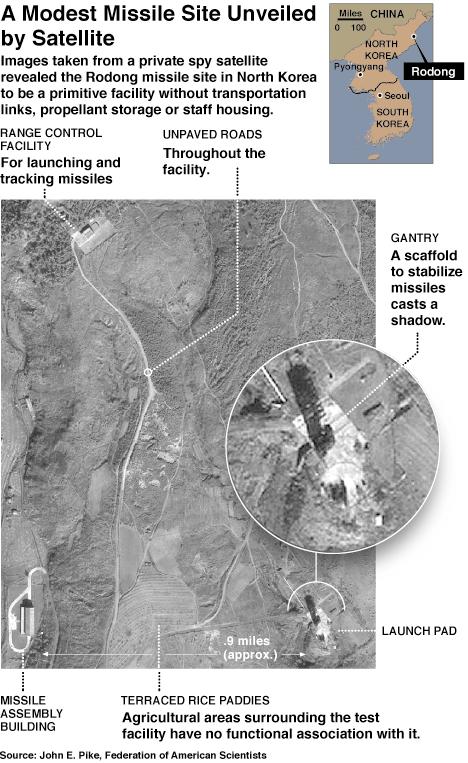The New York Times January 11, 2000
Spy Photos of Korea Missile Site Bring Dispute
By WILLIAM J. BROAD
The first detailed public images of a secretive North Korean missile base, taken by a private spy satellite and quietly released last week, show a small rural site that analysts clashed over yesterday as to whether it is perilously menacing or surprisingly primitive.
The most noteworthy features, said the Federation of American Scientists, a private group in Washington, were those missing: the rail links, paved roads, fuel tanks and staff housing needed to support a major program for long-range missiles.
"It's the mouse that roared," said John E. Pike, director of the group's space program and author of the analysis. "It's a singularly unimpressive facility, and we've looked at all the main ones in the world."
But other experts see the base, from which a missile was test-fired over Japan in August 1998, as a potentially deadly example of how little technological infrastructure is needed for a nation to have missiles that could threaten the United States.
"I'd be surprised if the base were anything but modest," said Frank J. Gaffney Jr., a former Pentagon official who directs the Center for Security Policy, a conservative private Washington group. "North Korea can't feed its own people. But if crude will do, then we're fools to ignore capabilities that have the potential to do us grave harm."
He said of all missile threats now facing the United States, "this is probably the highest."
The site, known as Rodong, is North Korean's only base for launching long-range missiles, and is used for test flights and potentially for mounting limited missile attacks. It has become an international flashpoint in recent years and one of the main threats cited by American proponents of a national antimissile system, which the Clinton administration says it is weighing.
The images of the top-secret military base were released quietly last week by Space Imaging Inc., a company in Thornton, Colo., which built the world's first private spy satellite and markets the photos. The company's space camera can make images of objects as small as three feet in diameter and show cars, roads, buildings, tanks, jets and missiles.
"It contributes to informed debate," Jeffrey K. Harris, president of Space Imaging, said yesterday of the North Korean imagery.
This site has long been a top priority for American spy satellites, but the government releases no information gathered by such surveillance.
The Russians have sold some crude imagery of the base, but Space Imaging's is by far the best made public.
The Federation of American Scientists, which generally backs arms control and has a program that studies space photos, published its analysis of the imagery on its web site, www.fas.org, under the heading "What's New."
The federation said the space photos show that the North Korean installation is roughly triangular, consisting of a single launch pad, a control facility and a building for assembling missiles. Those areas, it said, are linked by a network of unpaved roads and trails.
The federation called the base "barely worthy of note, consisting of the most minimal imaginable test infrastructure."
But Mr. Gaffney of the Center for Security Policy criticized the group as naïve, saying that only a more complete evaluation of the base by federal analysts working with a range of intelligence data and photos could reveal its true menace.
"This snapshot does not take into account what the North Koreans can get by way of help from clients and friends," he said. "There's lots of evidence they're getting help from China and the Russians. That's a whole different problem."
Copyright 2000 The New York Times Company

